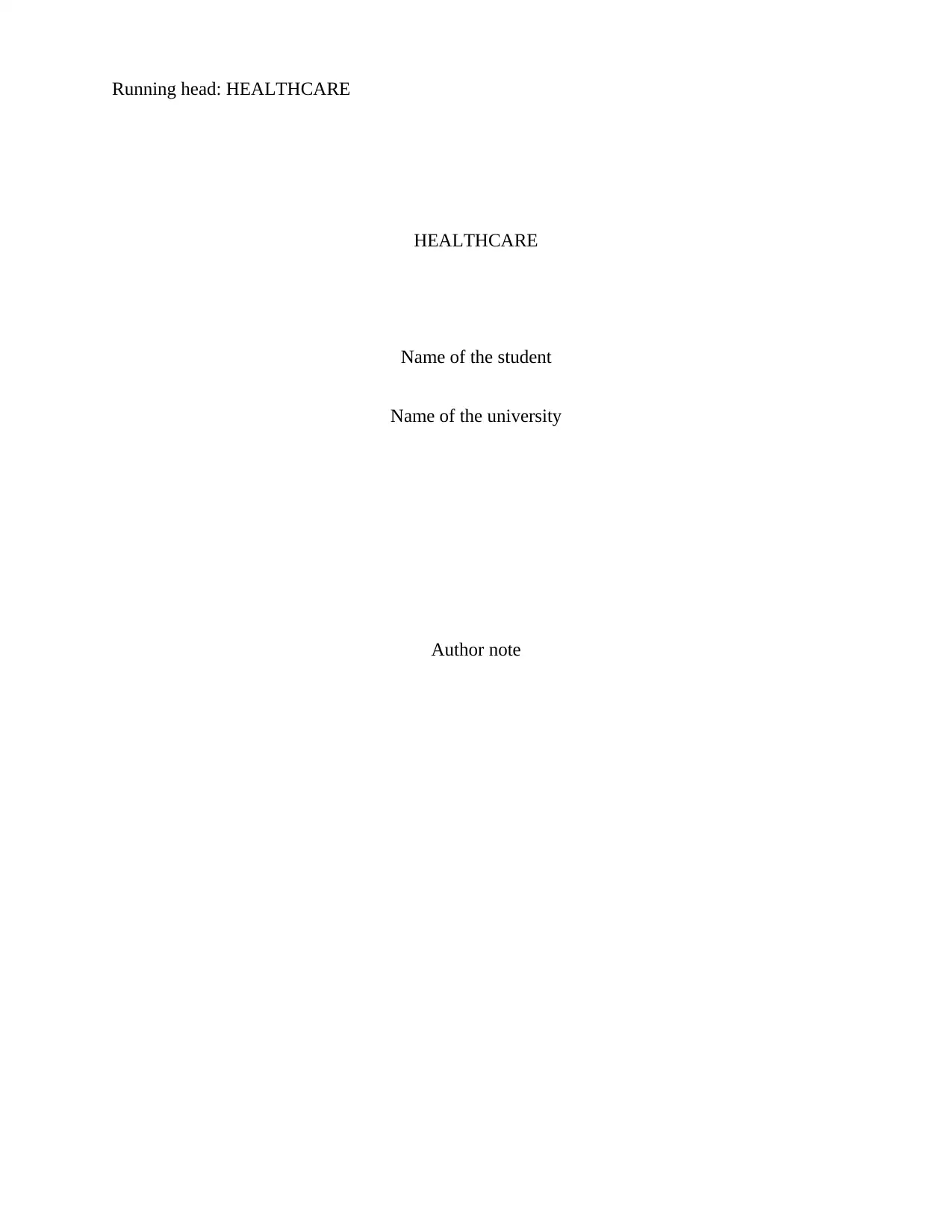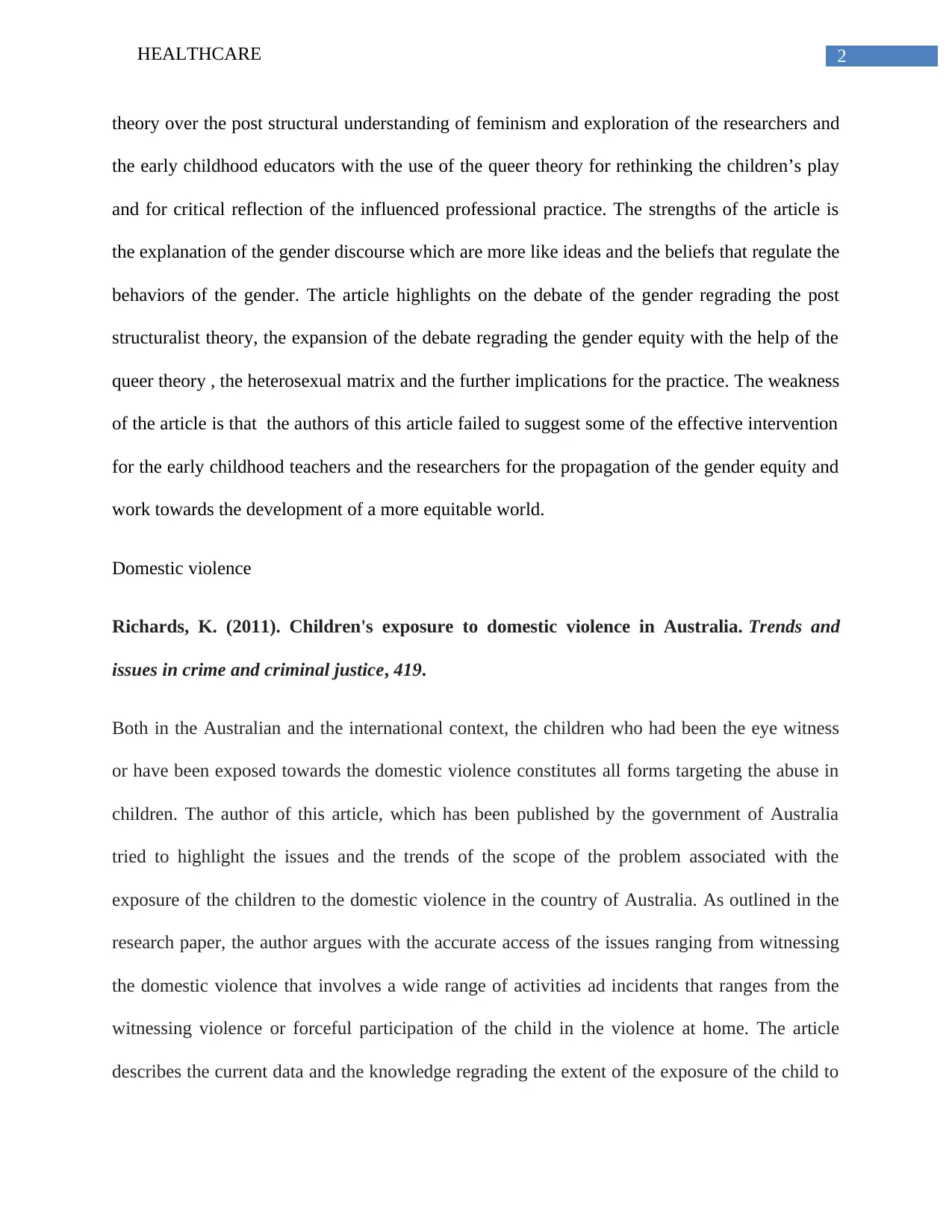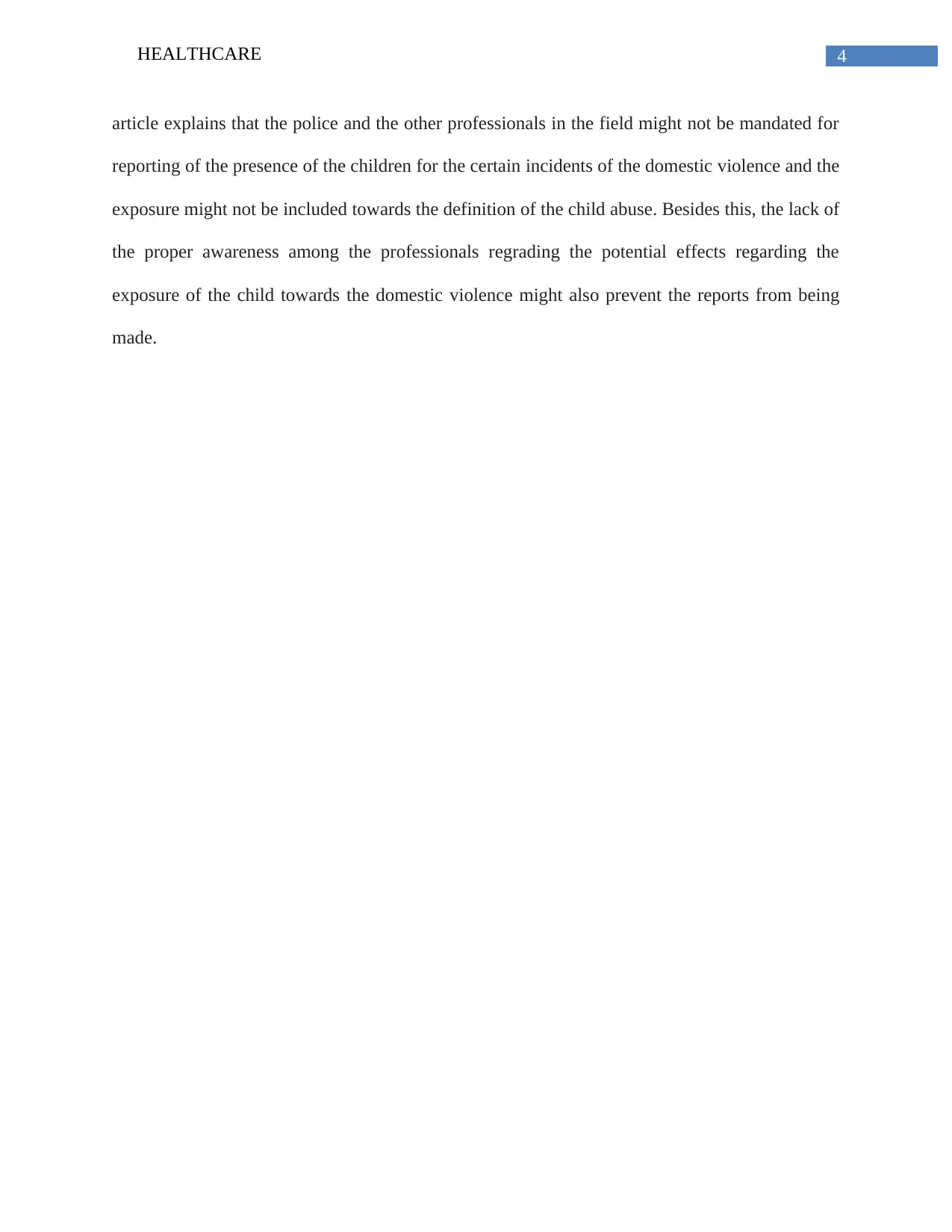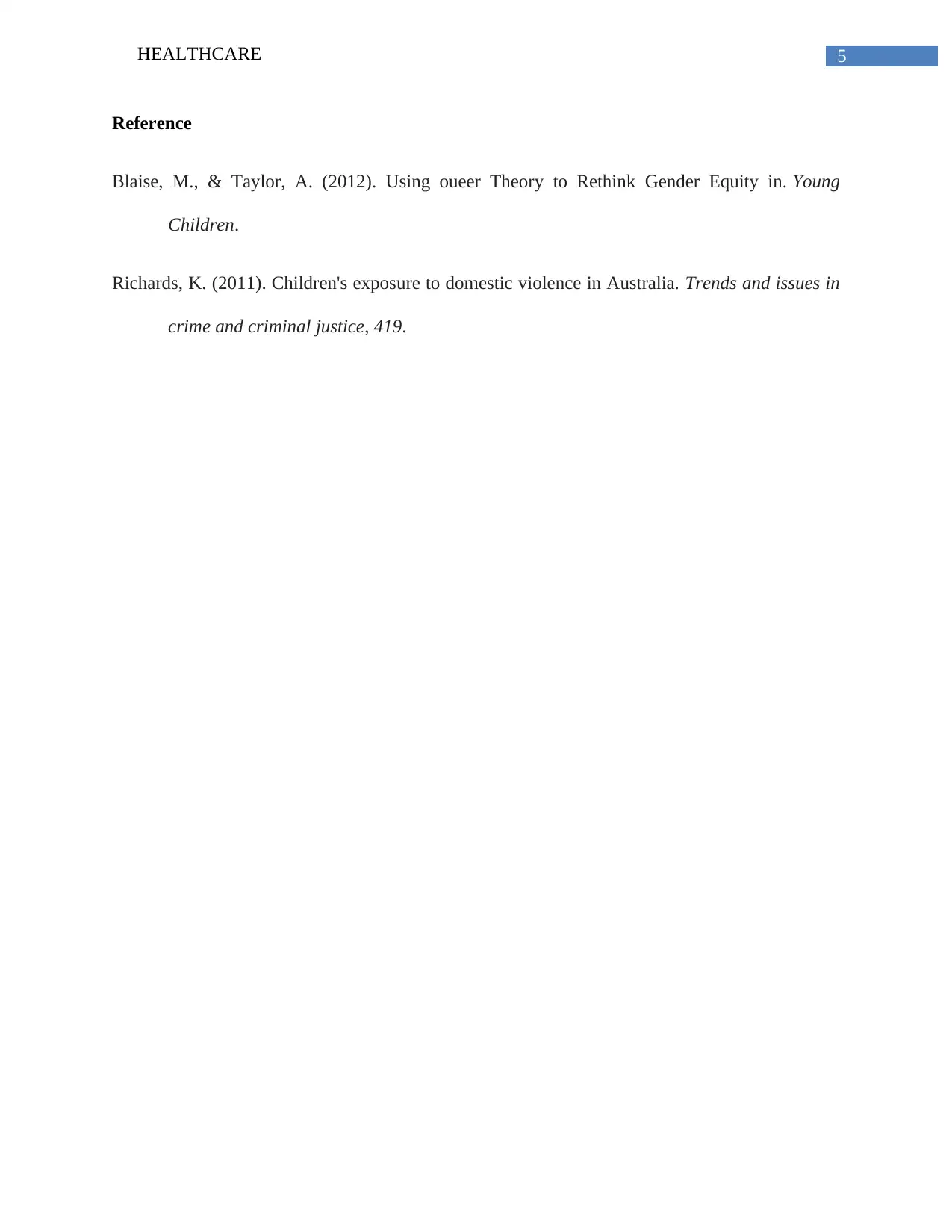Healthcare Report: Analysis of Gender and Domestic Violence
VerifiedAdded on 2023/02/01
|6
|1198
|37
Report
AI Summary
This report examines two key healthcare topics: gender and sexuality, and domestic violence, drawing on research articles. The first section analyzes Blaise and Taylor's (2012) study on using queer theory to rethink gender equity in early childhood education, discussing the theory's relevance in challenging gender stereotypes and promoting equitable practices. It highlights the article's strengths in explaining gender discourse and its weaknesses in suggesting practical interventions. The second section focuses on Richards' (2011) research on children's exposure to domestic violence in Australia, detailing the scope of the problem, the psychological, behavioral, and socio-economic impacts on children, and the recommended initiatives for addressing the issue, including legislative provisions and family violence programs. The report notes the strengths of the article in describing these effects and the weaknesses in the critiques of mandatory reporting requirements. The report provides a comprehensive overview of the challenges and complexities within these critical areas of healthcare.

Running head: HEALTHCARE
HEALTHCARE
Name of the student
Name of the university
Author note
HEALTHCARE
Name of the student
Name of the university
Author note
Paraphrase This Document
Need a fresh take? Get an instant paraphrase of this document with our AI Paraphraser

1HEALTHCARE
Gender and Sexuality
Blaise, M., & Taylor, A. (2012). Using oueer Theory to Rethink Gender Equity in. Young
Children.
The authors of this article highlighted over the context of the gender equity in the education of
the early childhood with the use of the queer theory. The article states the queer theory as the
new and the innovative approach regrading the gender that is relevant to the early childhood
educators for finding ways in the understanding and the challenging the stereotypes that has been
persistent through out. The article starts with highlighting a scenario of Harry and Alan
furthermore stating the children’s identity development. The authors of the article questioned
regrading the long debate of gender as the nature since children simply imitate the roles of the
gender what they see in their own families. The article focused on the truth regarding the failure
of the gender equity that everyone denies to accept. The stereotypes behavior of the gender is
thus a natural phenomenon. The authors of the article additionally insights over the persistent
stereotypes of the gender in the children that has been taken from the queer theory. The theory
furthermore insist that identity development of gender is linked with the heterosexual norms.
The theory furthermore argues with the fact that the heterosexual norms and not the socialization
and the biological instincts have a powerful influence over the gender behavior of the children.
In this article, the authors furthermore suggested a new term queer eye highlighting a new
perspectives towards looking at the gender. This particular new perspective does not assume that
any kind of gender is normal. The queer eye concept highlighted in the article looks down in the
ways where the gender behavior of the children reflects and reinforces the norms of the
heterosexuality. The authors of the article reviewed the gender equity process via the three steps.
This includes the explanation of the post structuralist theories of feminism, building up of queer
Gender and Sexuality
Blaise, M., & Taylor, A. (2012). Using oueer Theory to Rethink Gender Equity in. Young
Children.
The authors of this article highlighted over the context of the gender equity in the education of
the early childhood with the use of the queer theory. The article states the queer theory as the
new and the innovative approach regrading the gender that is relevant to the early childhood
educators for finding ways in the understanding and the challenging the stereotypes that has been
persistent through out. The article starts with highlighting a scenario of Harry and Alan
furthermore stating the children’s identity development. The authors of the article questioned
regrading the long debate of gender as the nature since children simply imitate the roles of the
gender what they see in their own families. The article focused on the truth regarding the failure
of the gender equity that everyone denies to accept. The stereotypes behavior of the gender is
thus a natural phenomenon. The authors of the article additionally insights over the persistent
stereotypes of the gender in the children that has been taken from the queer theory. The theory
furthermore insist that identity development of gender is linked with the heterosexual norms.
The theory furthermore argues with the fact that the heterosexual norms and not the socialization
and the biological instincts have a powerful influence over the gender behavior of the children.
In this article, the authors furthermore suggested a new term queer eye highlighting a new
perspectives towards looking at the gender. This particular new perspective does not assume that
any kind of gender is normal. The queer eye concept highlighted in the article looks down in the
ways where the gender behavior of the children reflects and reinforces the norms of the
heterosexuality. The authors of the article reviewed the gender equity process via the three steps.
This includes the explanation of the post structuralist theories of feminism, building up of queer

2HEALTHCARE
theory over the post structural understanding of feminism and exploration of the researchers and
the early childhood educators with the use of the queer theory for rethinking the children’s play
and for critical reflection of the influenced professional practice. The strengths of the article is
the explanation of the gender discourse which are more like ideas and the beliefs that regulate the
behaviors of the gender. The article highlights on the debate of the gender regrading the post
structuralist theory, the expansion of the debate regrading the gender equity with the help of the
queer theory , the heterosexual matrix and the further implications for the practice. The weakness
of the article is that the authors of this article failed to suggest some of the effective intervention
for the early childhood teachers and the researchers for the propagation of the gender equity and
work towards the development of a more equitable world.
Domestic violence
Richards, K. (2011). Children's exposure to domestic violence in Australia. Trends and
issues in crime and criminal justice, 419.
Both in the Australian and the international context, the children who had been the eye witness
or have been exposed towards the domestic violence constitutes all forms targeting the abuse in
children. The author of this article, which has been published by the government of Australia
tried to highlight the issues and the trends of the scope of the problem associated with the
exposure of the children to the domestic violence in the country of Australia. As outlined in the
research paper, the author argues with the accurate access of the issues ranging from witnessing
the domestic violence that involves a wide range of activities ad incidents that ranges from the
witnessing violence or forceful participation of the child in the violence at home. The article
describes the current data and the knowledge regrading the extent of the exposure of the child to
theory over the post structural understanding of feminism and exploration of the researchers and
the early childhood educators with the use of the queer theory for rethinking the children’s play
and for critical reflection of the influenced professional practice. The strengths of the article is
the explanation of the gender discourse which are more like ideas and the beliefs that regulate the
behaviors of the gender. The article highlights on the debate of the gender regrading the post
structuralist theory, the expansion of the debate regrading the gender equity with the help of the
queer theory , the heterosexual matrix and the further implications for the practice. The weakness
of the article is that the authors of this article failed to suggest some of the effective intervention
for the early childhood teachers and the researchers for the propagation of the gender equity and
work towards the development of a more equitable world.
Domestic violence
Richards, K. (2011). Children's exposure to domestic violence in Australia. Trends and
issues in crime and criminal justice, 419.
Both in the Australian and the international context, the children who had been the eye witness
or have been exposed towards the domestic violence constitutes all forms targeting the abuse in
children. The author of this article, which has been published by the government of Australia
tried to highlight the issues and the trends of the scope of the problem associated with the
exposure of the children to the domestic violence in the country of Australia. As outlined in the
research paper, the author argues with the accurate access of the issues ranging from witnessing
the domestic violence that involves a wide range of activities ad incidents that ranges from the
witnessing violence or forceful participation of the child in the violence at home. The article
describes the current data and the knowledge regrading the extent of the exposure of the child to
⊘ This is a preview!⊘
Do you want full access?
Subscribe today to unlock all pages.

Trusted by 1+ million students worldwide

3HEALTHCARE
the domestic violence in the country of Australia together with the registered effects of the
exposure over the children. The article explained the behavioral and the psychological effects,
the socio economic together with the health impacts lining with the intergenerational
transmission of the revictimization and also the violence. The article stated how the children
living in the houses that are characterized by the violence among the parents are the forgotten,
silent, secondary ad the invisible victim of the violence at home. The article highlighted the
phenomenon of witnessing violence which has never been defined that importantly. The strength
of the article lies on the effects of the exposure of the childhood towards the domestic violence
characterized by health and socio economic impacts, the intergenerational transmission of the
violence and more. The author of the article furthermore illustrated over the behavioral and the
psychological effects over children who are being exposed towards the violence at home. Factors
such as the anxiety, depression, increased level of aggression, lower social competencies,
antisocial behavior, lower level of self esteem, the mood related issues, the difficulties and
behavioral issues in education, loneliness impaired cognitive functioning and the increased
likelihood regrading the substance abuse. Another strength of the article is that recommended
initiatives for addressing the childhood exposure to the scenario of the domestic violence. The
article includes the table of the legislations that includes the provision for the exposed children to
the domestic violence. Another factor has been the mandatory reporting that has been introduced
in the jurisdictions towards the relation to the suspected abuse of the child and the factors of the
domestic violence , which has been the key feature regrading the policy and the legislation in the
domain. The article furthermore highlights some of the other approaches including the
addressing of the family violence program and more. The weakness of the article lies on the
critics towards the mandatory reporting requirements of the childhood violence exposure. The
the domestic violence in the country of Australia together with the registered effects of the
exposure over the children. The article explained the behavioral and the psychological effects,
the socio economic together with the health impacts lining with the intergenerational
transmission of the revictimization and also the violence. The article stated how the children
living in the houses that are characterized by the violence among the parents are the forgotten,
silent, secondary ad the invisible victim of the violence at home. The article highlighted the
phenomenon of witnessing violence which has never been defined that importantly. The strength
of the article lies on the effects of the exposure of the childhood towards the domestic violence
characterized by health and socio economic impacts, the intergenerational transmission of the
violence and more. The author of the article furthermore illustrated over the behavioral and the
psychological effects over children who are being exposed towards the violence at home. Factors
such as the anxiety, depression, increased level of aggression, lower social competencies,
antisocial behavior, lower level of self esteem, the mood related issues, the difficulties and
behavioral issues in education, loneliness impaired cognitive functioning and the increased
likelihood regrading the substance abuse. Another strength of the article is that recommended
initiatives for addressing the childhood exposure to the scenario of the domestic violence. The
article includes the table of the legislations that includes the provision for the exposed children to
the domestic violence. Another factor has been the mandatory reporting that has been introduced
in the jurisdictions towards the relation to the suspected abuse of the child and the factors of the
domestic violence , which has been the key feature regrading the policy and the legislation in the
domain. The article furthermore highlights some of the other approaches including the
addressing of the family violence program and more. The weakness of the article lies on the
critics towards the mandatory reporting requirements of the childhood violence exposure. The
Paraphrase This Document
Need a fresh take? Get an instant paraphrase of this document with our AI Paraphraser

4HEALTHCARE
article explains that the police and the other professionals in the field might not be mandated for
reporting of the presence of the children for the certain incidents of the domestic violence and the
exposure might not be included towards the definition of the child abuse. Besides this, the lack of
the proper awareness among the professionals regrading the potential effects regarding the
exposure of the child towards the domestic violence might also prevent the reports from being
made.
article explains that the police and the other professionals in the field might not be mandated for
reporting of the presence of the children for the certain incidents of the domestic violence and the
exposure might not be included towards the definition of the child abuse. Besides this, the lack of
the proper awareness among the professionals regrading the potential effects regarding the
exposure of the child towards the domestic violence might also prevent the reports from being
made.

5HEALTHCARE
Reference
Blaise, M., & Taylor, A. (2012). Using oueer Theory to Rethink Gender Equity in. Young
Children.
Richards, K. (2011). Children's exposure to domestic violence in Australia. Trends and issues in
crime and criminal justice, 419.
Reference
Blaise, M., & Taylor, A. (2012). Using oueer Theory to Rethink Gender Equity in. Young
Children.
Richards, K. (2011). Children's exposure to domestic violence in Australia. Trends and issues in
crime and criminal justice, 419.
⊘ This is a preview!⊘
Do you want full access?
Subscribe today to unlock all pages.

Trusted by 1+ million students worldwide
1 out of 6
Your All-in-One AI-Powered Toolkit for Academic Success.
+13062052269
info@desklib.com
Available 24*7 on WhatsApp / Email
![[object Object]](/_next/static/media/star-bottom.7253800d.svg)
Unlock your academic potential
Copyright © 2020–2025 A2Z Services. All Rights Reserved. Developed and managed by ZUCOL.